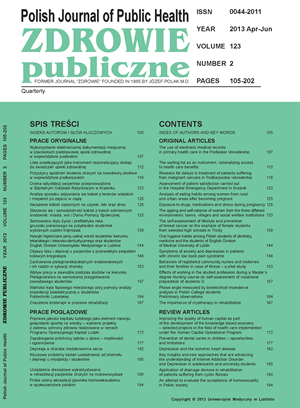Oral hygiene habits among Polish students of dentistry, medicine and the students of English Division of Medical University of Lublin
DOI:
https://doi.org/10.12923/j.0044-2011/123-2/a.09Keywords:
oral hygiene , questionnaire , oral health behaviors, Polish dental students , oral health knowledge and behaviors, dental students, medical studentsAbstract
Introduction. Proper oral hygiene has a significant effect on the health of the entire body, but frequent brushing of teeth and proper diet can substantially reduce dental caries risks.
Aim. The aim of the work is the comparison of oral hygiene habits among Polish and foreign students of Medical University of Lublin.
Material and methods. We have carried out a survey among 279 Students of Medical University of Lublin. The respondents comprised 189 students from Poland and 90 students of English Division who come from USA, Canada, Taiwan, India, and Norway. The survey questions concerned the frequency of tooth brushing, consumption of sweets, and dental office visits. The results were statistically analysed.
Results. The results are summarized in Tables 1-5. The respondents were divided into two groups: Polish and foreign students. Statistical analysis has revealed statistically significant difference between Polish and foreign students concerning the frequency of dental office visits, brushing teeth, tongue cleaning, and subjective evaluation of oral health condition. There is no statistically significant difference in frequency of sweets consumption.
Discussion. Research results concerning oral health care awareness of the students of Medical University of Lublin were compared to the results of Kawamura from Hiroshima, Usman from India, Wędrychowicz-Welman from Poznań, among others.
Conclusions. Students of Medical University of Lublin demonstrate sufficient level of oral health awareness. Foreign students visit dental office more often to check-up their teeth. Both groups of respondents usually brush their teeth two times a day, regularly clean tongue and evaluate their oral health condition as good.
References
1. Zawada Ł, Matuszewska A, Chrzęszczyk D, Konopka T. Utrata zębów u dorosłych mieszkańców Wrocławia. Dent Med Probl. 2012;49(3):391-8.
2. Chen SC, Chueh LH, Hsiao CK, et al. First untoward events and reasons for tooth extraction after nonsurgical endodontic treatment in Taiwan. J Endod. 2008;34:671-4.
3. Da’ameh D. Reasons for permanent tooth extraction in the North of Afghanistan. J Dent. 2006;34:48-51.
4. Beaglehole R, Benzian H, Crail J, et al. The Oral Health Atlas: Mapping a Neglected Global Health Issue. Brighton UK: FDI World Dental Fede-ration, Myriam Editions; 2009. ISBN-10:0953926168.
5. Kawamura T, Kwan SYL, Hu DY, et al. A comparative study of oral health attitudes and behaviour using the Hiroshima University – Dental Behavioural Inventory (HU-DBI) between dental students in Britain and China. J Oral Sci. 2005;47:1-7.
6. Usman S, Bhat SS, Sargod SS. Oral health knowledge and behavior of clinical medical, dental and paramedical students in Mangalore. JOHCD. 2007;1:46-8.
7. Wędrychowicz-Welman A, Prymas A, Lewandowski P, Uram K. Stan jamy ustnej i stomatologiczne zachowania prozdrowotne studentów stomatologii. Dent Med Prob. 2006;43(2):222-7.
8. Kaczmarek U, Mysiak-Dębska M, Dębska-Łasut K. Wiedza i zachowania prozdrowotne dotyczące jamy ustnej studentów pierwszych lat studiów stomatologii i medycyny. Dent Med Prob. 2011;48(4):532-40.
9. Touma S, Lenkiewicz R, Tatarski P, et al. Świadomość higieniczna i stan higieny jamy ustnej studentów stomatologii na podstawie badań ankietowego i klinicznego. Stom Współcz. 1999;(6):13-7.


